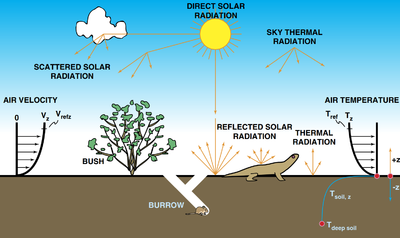Difference between revisions of "Microclimate"
m (→In Soils) |
|||
| Line 4: | Line 4: | ||
==In Soils== | ==In Soils== | ||
Consideration of the microclimate is particularly important in [[soil]] [[ecology]], as the heterogenous nature of soil means that numerous microclimates are present in very small areas of soils. This high heterogeneity of conditions may contribute to high soil biodiversity. | Consideration of the microclimate is particularly important in [[soil]] [[ecology]], as the heterogenous nature of soil means that numerous microclimates are present in very small areas of soils. This high heterogeneity of conditions may contribute to high soil biodiversity. | ||
| − | Soil microclimate can affect macroaggregate dynamics and [[Aggregate formation]]. Soil erodability is reduced in warmer climates, which prevents the occurrence of fragile microaggregates caused by freeze-thaw events. | + | Soil microclimate can affect macroaggregate dynamics and [[Aggregate formation]][4]. Soil erodability is reduced in warmer climates, which prevents the occurrence of fragile microaggregates caused by freeze-thaw events. |
| + | |||
==References== | ==References== | ||
1. Kearney, M. R., Isaac, A. P. & Porter, W. P. microclim: Global estimates of hourly microclimate based on long-term monthly climate averages. ''Sci Data'' '''1''', 140006 (2014). | 1. Kearney, M. R., Isaac, A. P. & Porter, W. P. microclim: Global estimates of hourly microclimate based on long-term monthly climate averages. ''Sci Data'' '''1''', 140006 (2014). | ||
Revision as of 15:20, 5 May 2021
Microclimate is the set of atmospheric conditions that occur in a local area as a result of environmental heterogeneity near the Earth’s surface. Microclimates play an integral role in ecosystem processes. Microclimatic variations in energy and moisture directly affect a number of key ecological processes in forest ecosystems occurring at multiple spatial and temporal scales.
Influences on Microclimate
The two major sources of microclimate variability are differences in energy and moisture, or temperature and humidity. However, succession is often community driven even if there are harsher abiotic limits set, so herbaceous and woody species also have an influence. Differences in temperature and humidity can have numerous drivers, including aspect, (direction that a slope faces,) successional stage, vegetation and canopy presence. The presence of bodies of water can also influence microclimate, as they may increase humidity and stabilize temperature.
In Soils
Consideration of the microclimate is particularly important in soil ecology, as the heterogenous nature of soil means that numerous microclimates are present in very small areas of soils. This high heterogeneity of conditions may contribute to high soil biodiversity. Soil microclimate can affect macroaggregate dynamics and Aggregate formation[4]. Soil erodability is reduced in warmer climates, which prevents the occurrence of fragile microaggregates caused by freeze-thaw events.
References
1. Kearney, M. R., Isaac, A. P. & Porter, W. P. microclim: Global estimates of hourly microclimate based on long-term monthly climate averages. Sci Data 1, 140006 (2014).
2. Breshears, D. D., Nyhan, J. W., Heil, C. E. & Wilcox, B. P. Effects of Woody Plants on Microclimate in a Semiarid Woodland: Soil Temperature and Evaporation in Canopy and Intercanopy Patches. International Journal of Plant Sciences 159, 1010–1017 (1998).
3. Blackith, R. M. Interrelationships between Small Arthropods and Nematodes in Peat. Proceedings of the Royal Irish Academy, Section B: Biological, Geological, and Chemical Science 75, 12 (1975).
4. Cécillon, L., de Mello, N. A., De Danieli, S. & Brun, J.-J. Soil macroaggregate dynamics in a mountain spatial climate gradient. Biogeochemistry 97, 31–43 (2010).
5. Kaufman, D. W., Peterson, S. K., Fristik, R. & Kaufman, G. A. Effect of Microhabitat Features on Habitat Use by Peromyscus leucopus. American Midland Naturalist 110, 177 (1983).
6. Tsuyuzaki, S., Matsuda, M. & Akasaka, M. Effect of a deciduous shrub on microclimate along an elevation gradient, Mount Koma, northern Japan. Clim. Res. 51, 1–10 (2012).
7. Frey, S. J. K., Hadley, A. S. & Betts, M. G. Microclimate predicts within-season distribution dynamics of montane forest birds. Diversity Distrib. 22, 944–959 (2016).
8. Kraichak, E. Microclimate Fluctuation Correlated with Beta Diversity of Epiphyllous Bryophyte Communities. Biotropica 46, 575–582 (2014).
